Do you have a question about the Philips 28PT4458/01 and is the answer not in the manual?
Core technical details like display type, screen size, tuning system, and color systems.
Details side and rear connections for audio, video, and interface ports.
Overview of main printed circuit boards (PWBs) and their locations within the chassis.
Instructions on how to download user information from the Philips website.
Detailed steps for safely disassembling the television set, starting with rear cover removal.
Instructions on how to place the mono carrier into its service position for maintenance.
Procedures for removing front interface, side AV, and other assemblies from the chassis.
Instructions for re-assembling the television set, emphasizing reverse order and final checks.
Overview of test points on circuit board assemblies, referring to functional blocks and diagrams.
Explains Service Default Mode (SDM), Service Alignment Mode (SAM), and Customer Service Mode (CSM).
Purpose, specifications, and entry method for Service Default Mode (SDM).
Purpose, specifications, and entry method for Service Alignment Mode (SAM).
Purpose and entry method for Customer Service Mode (CSM) for call center interaction.
Troubleshooting tips for common picture problems like brightness, sharpness, and color issues.
Detailed steps to adjust brightness, sharpness, and color for picture quality issues.
Introduction and specifications for ComPair, a hardware interface for PC-based faultfinding.
Explains how to read and clear the error code buffer, and lists error codes.
Methods to read the error buffer via SDAM, blinking LED, or ComPair.
Procedures for clearing the error code buffer using SDAM or automatic reset.
Procedure to make error buffer contents visible via the front LED when no picture is present.
Explains error generation and protection modes, including blinking LED indication.
General tips and assumptions for fault finding and repair actions.
How to directly change NVM contents using the NVM Editor in SAM mode.
Fault finding trees for 'Set not working' and 'Set does not start up' related to the power supply.
Fault finding trees for 'One thin vertical line' and 'Blank screen' related to deflection issues.
Troubleshooting steps for issues with AV input or missing AV signals.
Troubleshooting guide for 'No Picture' issues related to the tuner and IF stages.
Guidelines for troubleshooting the Micro Controller function, especially during startup issues.
Troubleshooting guide for 'No Picture' in RF or AV modes related to video processing.
Troubleshooting guide for 'No Sound' issues with RF or AV inputs.
Troubleshooting for no audio at the loudspeaker, checking amplifier IC.
Shows the overall wiring connections between different panels and components in the TV.
Block diagram illustrating the power supply and deflection circuits and their interconnections.
Block diagram showing the video processing path, including tuner, Hercules, and CRT connections.
Block diagram detailing audio processing, control signals, and connections to various panels.
Overview of I2C bus interconnections and supply voltage distribution throughout the chassis.
Circuit diagram and PWB layout for the main power supply (A1).
Table showing default values for power supply components across different regions and ranges.
Circuit diagram and PWB layout for the line and frame deflection system (A2).
Table detailing deflection component values based on region, screen size, and tube type.
Circuit diagram and PWB layout for the tuner IF section (A3).
Circuit diagram for the Hercules UOC processor (A4), showing its internal architecture.
Circuit diagram and PWB layout for features and connectivity interfaces (A5).
Circuit diagram and PWB layout for the Class D audio amplifier (A6).
Circuit diagram and PWB layout for the audio amplifier (A7), likely the TDA2616Q.
Circuit diagram and PWB layout for the rear I/O SCART connectors (A8).
Circuit diagram and PWB layout for the front control panel (A9), including IR receiver and buttons.
Circuit diagram for the DVD power supply module (A10).
Circuit diagram and PWB layout for the CRT panel (B1), including high voltage and signal connections.
Circuit diagram and PWB layout for the Eco Scavem circuit (B2) used for picture sharpness.
Circuit diagram and PWB layout for the side AV input and headphone panel (D).
Circuit diagram and PWB layout for the side AV input and headphone panel (D) for FL-13 styling.
Circuit diagram and PWB layout for the top control panel (E) for PV2 styling.
Circuit diagram and PWB layout for the top control panel (E) for FL-13 styling.
Circuit diagram and PWB layout for the power supply PIP panel (F1).
Circuit diagram and PWB layout for the tuner IF and demodulator PIP panel (F2).
Circuit diagram and PWB layout for the linearity and panorama panel (G).
Circuit diagram and PWB layout for the LTI/CTI interface panel (H).
Circuit diagram and PWB layout for the front interface panel (J) for FL-13 styling.
Circuit diagram and PWB layout for the front interface panel (J) for PV-2 styling.
Circuit diagram and PWB layout for the front interface and keyboard panel (J).
Conditions and setup required before performing any electrical alignments on the television set.
Procedures for hardware adjustments like Vg2, focusing, and geometry corrections.
Overview of software alignments and settings accessible via Service Modes (SAM).
Detailed explanation of how to change option bytes and their impact on TV functions.
Continues the explanation of option byte settings for various TV features and regional configurations.
Further details on Option Bytes, explaining the function of each bit for specific features.
Alignment procedure for the tuner, focusing on AGC adjustment.
Procedure for adjusting white tone settings, including black cut-off levels for different color temperatures.
Detailed alignment procedures for picture geometry, including horizontal and vertical adjustments.
Notes on audio alignments, default values for QSS, FMI, and NICAM settings.
Introduction to the L04 chassis, its features, CRT types, and standard architecture.
Description of the power supply system, including block diagram and standby/power down signals.
Block diagram of the power supply, showing its main components and voltage outputs.
Timing diagrams illustrating power on, standby, and power off sequences.
Explanation of the power-on startup sequence for the television set.
Description of the standby mode operation and voltage supply to Hercules.
Explanation of deflection synchronization, horizontal, and vertical deflection principles.
Details on how the Hercules generates horizontal drive pulses and the role of supply voltages.
Principles of horizontal deflection, including scan periods, flyback, and linearity correction.
Lists and describes auxiliary voltages derived from the LOT for various circuits.
Explanation of beam current adjustment, BCL, and EHT-info characteristics.
Explanation of the X-ray protection circuit and its trigger mechanism for EHT.
Description of the vertical deflection stage, including differential drive and component functions.
Explanation of the rotation control signal and its amplification for picture rotation.
Description of the CRT panel's RGB amplifier stage and Scavem feature.
Description of the Micro Controller (Hercules), NVM IC, and Teletext/CC decoder.
Block diagram of the Micro Controller application, showing its interfaces and functions.
Supply voltages and basic specifications for the Micro Controller.
Overview of Micro Controller port configurations and functions.
Description of the tuner and IF system, including features and diversity.
Explanation of tuner diversity concepts and their impact on sound/video standards.
Pin assignments and functions for the tuner and SAW filters.
Details on tuner option settings accessible via SAM mode.
Description of audio/video source selection controlled by the Hercules.
Explanation of option settings for source selection accessible in SAM mode.
Details on AV source select diversity based on region and set specifications.
Description of video processing features, including brightness, contrast, sharpness, and LTI/CTI.
Features of the Hercules and TDA9178 chips for video processing.
Block diagram of the video processing part, showing signal flow.
Explanation of the TDA9178 IC's Luminance and Color Transient Improvement functions.
Description of audio decoding via Hercules, including analog and digital decoders, and diversity concepts.
Explanation of audio decoding diversity concepts (QSS, Inter Carrier) and region-specific standards.
Features of the Hercules for audio processing, including tone controls and surround effects.
Description of the audio amplifier part, its specifications, and output power.
Explanation of the PIP application, tuners, and the components involved.
List of abbreviations used throughout the service manual, with their definitions.
Continuation of the abbreviation list, defining technical terms used in the manual.
Further continuation of the abbreviation list, defining more technical terms.
List of spare parts for the main television set, including various components and accessories.
List of spare parts for the main mono carrier board, detailing component part numbers and values.
Continuation of the mono carrier spare parts list, covering a wide range of electronic components.
Further continuation of the mono carrier spare parts list, including components for specific panels.
Spare parts list for the LTI/CTI interface panel.
Spare parts list for the side AV and headphone panel.
Spare parts list for the top control panel.
Spare parts list for the front interface panel.
Internal block diagram and pin configuration for the TDA9887 IC.
Internal block diagram and pin configuration for the TDA9178 IC.
Core technical details like display type, screen size, tuning system, and color systems.
Details side and rear connections for audio, video, and interface ports.
Overview of main printed circuit boards (PWBs) and their locations within the chassis.
Instructions on how to download user information from the Philips website.
Detailed steps for safely disassembling the television set, starting with rear cover removal.
Instructions on how to place the mono carrier into its service position for maintenance.
Procedures for removing front interface, side AV, and other assemblies from the chassis.
Instructions for re-assembling the television set, emphasizing reverse order and final checks.
Overview of test points on circuit board assemblies, referring to functional blocks and diagrams.
Explains Service Default Mode (SDM), Service Alignment Mode (SAM), and Customer Service Mode (CSM).
Purpose, specifications, and entry method for Service Default Mode (SDM).
Purpose, specifications, and entry method for Service Alignment Mode (SAM).
Purpose and entry method for Customer Service Mode (CSM) for call center interaction.
Troubleshooting tips for common picture problems like brightness, sharpness, and color issues.
Detailed steps to adjust brightness, sharpness, and color for picture quality issues.
Introduction and specifications for ComPair, a hardware interface for PC-based faultfinding.
Explains how to read and clear the error code buffer, and lists error codes.
Methods to read the error buffer via SDAM, blinking LED, or ComPair.
Procedures for clearing the error code buffer using SDAM or automatic reset.
Procedure to make error buffer contents visible via the front LED when no picture is present.
Explains error generation and protection modes, including blinking LED indication.
General tips and assumptions for fault finding and repair actions.
How to directly change NVM contents using the NVM Editor in SAM mode.
Fault finding trees for 'Set not working' and 'Set does not start up' related to the power supply.
Fault finding trees for 'One thin vertical line' and 'Blank screen' related to deflection issues.
Troubleshooting steps for issues with AV input or missing AV signals.
Troubleshooting guide for 'No Picture' issues related to the tuner and IF stages.
Guidelines for troubleshooting the Micro Controller function, especially during startup issues.
Troubleshooting guide for 'No Picture' in RF or AV modes related to video processing.
Troubleshooting guide for 'No Sound' issues with RF or AV inputs.
Troubleshooting for no audio at the loudspeaker, checking amplifier IC.
Shows the overall wiring connections between different panels and components in the TV.
Block diagram illustrating the power supply and deflection circuits and their interconnections.
Block diagram showing the video processing path, including tuner, Hercules, and CRT connections.
Block diagram detailing audio processing, control signals, and connections to various panels.
Overview of I2C bus interconnections and supply voltage distribution throughout the chassis.
Circuit diagram and PWB layout for the main power supply (A1).
Table showing default values for power supply components across different regions and ranges.
Circuit diagram and PWB layout for the line and frame deflection system (A2).
Table detailing deflection component values based on region, screen size, and tube type.
Circuit diagram and PWB layout for the tuner IF section (A3).
Circuit diagram for the Hercules UOC processor (A4), showing its internal architecture.
Circuit diagram and PWB layout for features and connectivity interfaces (A5).
Circuit diagram and PWB layout for the Class D audio amplifier (A6).
Circuit diagram and PWB layout for the audio amplifier (A7), likely the TDA2616Q.
Circuit diagram and PWB layout for the rear I/O SCART connectors (A8).
Circuit diagram and PWB layout for the front control panel (A9), including IR receiver and buttons.
Circuit diagram for the DVD power supply module (A10).
Circuit diagram and PWB layout for the CRT panel (B1), including high voltage and signal connections.
Circuit diagram and PWB layout for the Eco Scavem circuit (B2) used for picture sharpness.
Circuit diagram and PWB layout for the side AV input and headphone panel (D).
Circuit diagram and PWB layout for the side AV input and headphone panel (D) for FL-13 styling.
Circuit diagram and PWB layout for the top control panel (E) for PV2 styling.
Circuit diagram and PWB layout for the top control panel (E) for FL-13 styling.
Circuit diagram and PWB layout for the power supply PIP panel (F1).
Circuit diagram and PWB layout for the tuner IF and demodulator PIP panel (F2).
Circuit diagram and PWB layout for the linearity and panorama panel (G).
Circuit diagram and PWB layout for the LTI/CTI interface panel (H).
Circuit diagram and PWB layout for the front interface panel (J) for FL-13 styling.
Circuit diagram and PWB layout for the front interface panel (J) for PV-2 styling.
Circuit diagram and PWB layout for the front interface and keyboard panel (J).
Conditions and setup required before performing any electrical alignments on the television set.
Procedures for hardware adjustments like Vg2, focusing, and geometry corrections.
Overview of software alignments and settings accessible via Service Modes (SAM).
Detailed explanation of how to change option bytes and their impact on TV functions.
Continues the explanation of option byte settings for various TV features and regional configurations.
Further details on Option Bytes, explaining the function of each bit for specific features.
Alignment procedure for the tuner, focusing on AGC adjustment.
Procedure for adjusting white tone settings, including black cut-off levels for different color temperatures.
Detailed alignment procedures for picture geometry, including horizontal and vertical adjustments.
Notes on audio alignments, default values for QSS, FMI, and NICAM settings.
Introduction to the L04 chassis, its features, CRT types, and standard architecture.
Description of the power supply system, including block diagram and standby/power down signals.
Block diagram of the power supply, showing its main components and voltage outputs.
Timing diagrams illustrating power on, standby, and power off sequences.
Explanation of the power-on startup sequence for the television set.
Description of the standby mode operation and voltage supply to Hercules.
Explanation of deflection synchronization, horizontal, and vertical deflection principles.
Details on how the Hercules generates horizontal drive pulses and the role of supply voltages.
Principles of horizontal deflection, including scan periods, flyback, and linearity correction.
Lists and describes auxiliary voltages derived from the LOT for various circuits.
Explanation of beam current adjustment, BCL, and EHT-info characteristics.
Explanation of the X-ray protection circuit and its trigger mechanism for EHT.
Description of the vertical deflection stage, including differential drive and component functions.
Explanation of the rotation control signal and its amplification for picture rotation.
Description of the CRT panel's RGB amplifier stage and Scavem feature.
Description of the Micro Controller (Hercules), NVM IC, and Teletext/CC decoder.
Block diagram of the Micro Controller application, showing its interfaces and functions.
Supply voltages and basic specifications for the Micro Controller.
Overview of Micro Controller port configurations and functions.
Description of the tuner and IF system, including features and diversity.
Explanation of tuner diversity concepts and their impact on sound/video standards.
Pin assignments and functions for the tuner and SAW filters.
Details on tuner option settings accessible via SAM mode.
Description of audio/video source selection controlled by the Hercules.
Explanation of option settings for source selection accessible in SAM mode.
Details on AV source select diversity based on region and set specifications.
Description of video processing features, including brightness, contrast, sharpness, and LTI/CTI.
Features of the Hercules and TDA9178 chips for video processing.
Block diagram of the video processing part, showing signal flow.
Explanation of the TDA9178 IC's Luminance and Color Transient Improvement functions.
Description of audio decoding via Hercules, including analog and digital decoders, and diversity concepts.
Explanation of audio decoding diversity concepts (QSS, Inter Carrier) and region-specific standards.
Features of the Hercules for audio processing, including tone controls and surround effects.
Description of the audio amplifier part, its specifications, and output power.
Explanation of the PIP application, tuners, and the components involved.
List of abbreviations used throughout the service manual, with their definitions.
Continuation of the abbreviation list, defining technical terms used in the manual.
Further continuation of the abbreviation list, defining more technical terms.
List of spare parts for the main television set, including various components and accessories.
List of spare parts for the main mono carrier board, detailing component part numbers and values.
Continuation of the mono carrier spare parts list, covering a wide range of electronic components.
Further continuation of the mono carrier spare parts list, including components for specific panels.
Spare parts list for the LTI/CTI interface panel.
Spare parts list for the side AV and headphone panel.
Spare parts list for the top control panel.
Spare parts list for the front interface panel.
Internal block diagram and pin configuration for the TDA9887 IC.
Internal block diagram and pin configuration for the TDA9178 IC.

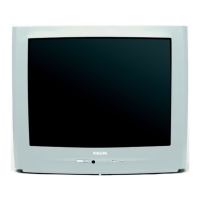
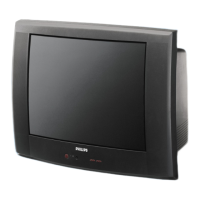
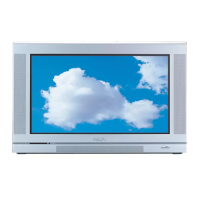
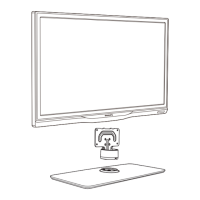
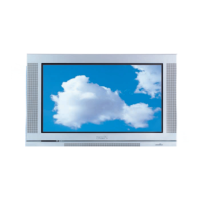
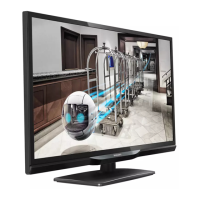

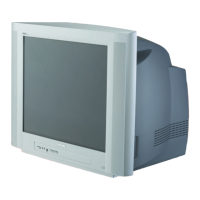



